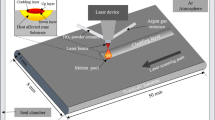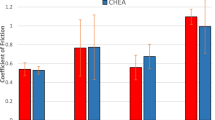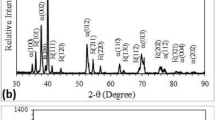Abstract
There are several ways to characterize the wear resistance of coatings in the laboratory, almost all of them applying relatively low loads, both punctually and more widely. Pin-on-disc, reciprocal sliding, and micro-abrasion wear tests are quite common configurations for this purpose. Thus, a gap was identified in terms of characterization of hard PVD coatings subject to higher loads. This work aims to study and compare the wear behavior of two different coatings obtained by PVD, both monolayer, B4C (boron carbide) and TiB2 (titanium diboride), focused on identifying the wear mechanisms present in different coatings provided with high hardness. Both coatings were initially characterized in terms of chemical composition, thickness, morphology, structure, hardness, and adhesion to the substrate, being subsequently tested in laboratory equipment for wear tests following the block-on-ring configuration and relatively high loads; with a view to study the failure mechanisms of the coatings and their wear rate, it was found that the main wear mechanism, sustained by the analyzed coatings, was abrasive wear in the contact area. In the craters left by the tests, it was determined that the main wear mechanism was two-body abrasion. The B4C and TiB2 coatings performed well in relation to the load and configuration used, in line with the behavior already observed in other used wear test configurations. However, under the imposed conditions, and comparing the two coatings, TiB2 is the best option when high loads need to be applied to the coated surfaces, as these coatings did not suffer perforation during testing and the amount of removed volume was inferior to that of the B4C coated samples.
















Similar content being viewed by others
Availability of data and materials
No data or materials are available regarding this work.
References
Vuoristo P (2014) Plasma polymer deposition and coatings on polymers. In: Hashmi S, Van Tyne CJ, Batalha GF, Yilbas B (Eds.), Comprehensive Materials Processing (vol. 4). Elsevier, Amsterdam, The Netherland, p 201–228. ISBN: 978-0-08-096533-8
Holmberg K, Matthews A (2009) Coatings tribology - properties, mechanisms, techniques and applications in surface engineering (2nd Ed.). Elsevier Amsterdam, The Netherland. ISBN: 9780444527509
Baptista A, Silva F, Porteiro J, Míguez J, Pinto G (2018) Sputtering physical vapour deposition (PVD) coatings: a critical review on process improvement and market trend demands. Coatings 8:402. https://doi.org/10.3390/coatings8110402
Bhandarkar LR, Behera M, Mohanty PP, Sarangi SK (2021) Experimental investigation and multi-objective optimization of process parameters during machining of AISI 52100 using high performance coated tools. Measurement 172:108842. https://doi.org/10.1016/j.measurement.2020.108842
Sousa VFC, Silva FJG (2020) Recent advances in turning processes using coated tools—a comprehensive review. Metals 10(2):170. https://doi.org/10.3390/met10020170
Sousa VFC, Silva FJG (2020) Recent advances on coated milling tool technology—a comprehensive review. Coatings 10(3):235. https://doi.org/10.3390/coatings10030235
Sousa VFC, Silva FJG, Pinto GF, Baptista A, Alexandre R (2021) Characteristics and wear mechanisms of TiAlN-based coatings for machining applications: a comprehensive review. Metals 11:260. https://doi.org/10.3390/met11020260
Koseki S, Inoue K, Morito S, Ohba T, Usuki H (2015) Comparison of TiN-coated tools using CVD and PVD processes during continuous cutting of Ni-based superalloys. Surf Coat Technol 283:353–363. https://doi.org/10.1016/j.surfcoat.2015.10.071
Martinho RP, Silva FJG, Martins C, Lopes H (2019) Comparative study of PVD and CVD cutting tools performance in milling of duplex stainless steel. Int J Adv Manuf Technol 102:2423–2439. https://doi.org/10.1007/s00170-019-03351-8
Sousa VFC, Silva FJG, Alexandre R, Fecheira JS, Silva FPN (2021) Study of the wear behaviour of TiAlSiN and TiAlN PVD coated tools on milling operations of pre-hardened tool steel. Wear 476:203695. https://doi.org/10.1016/j.wear.2021.203695
Cora ÖN, Ağcayazı A, Namiki K, Sofuoğlu H, Koç M (2012) Die wear in stamping of advanced high strength steels – investigations on the effects of substrate material and hard-coatings. Tribol Int 52:50–60. https://doi.org/10.1016/j.triboint.2012.02.016
Fernandes L, Silva FJG, Andrade MF, Alexandre R, Baptista APM, Rodrigues C (2017) Improving the punch and die wear behavior in tin coated steel stamping process. Surf Coat Technol 332:174–189. https://doi.org/10.1016/j.surfcoat.2017.06.086
Zheng K, Dong Y, Dong H, Fernandez J, Dean TA (2017) Investigation of the lubrication performance using WC: C coated tool surfaces for hot stamping AA6082. Proc Eng 207:711–716. https://doi.org/10.1016/j.proeng.2017.10.1046
Zabala B, Fernandez X, Rodriguez JC, López-Ortega A, Fuentes E, Bayón R, Igartua A, Girot F (2019) Mechanism-based wear models for plastic injection moulds. Wear 440–441:203105. https://doi.org/10.1016/j.wear.2019.203105
Silva FJG, Martinho R, Andrade M, Baptista APM, Alexandre R (2017) Improving the wear resistance of moulds for the injection of glass fibre-reinforced plastics using PVD coatings: a comparative study. Coatings 7:28. https://doi.org/10.3390/coatings7020028
Silva FJG, Martinho RP, Alexandre RJD, Baptista APM (2011) Increasing the wear resistance of molds for injection of glass fiber reinforced plastics. Wear 271:2494–2499. https://doi.org/10.1016/j.wear.2011.01.074
Marina E, Boschetto F, Zanocco M, Zhu W, Adachi T, Kanamura N, Yamamoto T, McEntire BJ, Jones EN, Powell C, Hendry J, Bock RM, Bal BS, Pezzotti G (2021) Biological responses to silicon and nitrogen-rich PVD silicon nitride coatings. Mater Today Chem 19:100404. https://doi.org/10.1016/j.mtchem.2020.100404
Kim K-C (2015) Effective graded refractive-index anti-reflection coating for high refractive-index polymer ophthalmic lenses. Mater Lett 160:158–161. https://doi.org/10.1016/j.matlet.2015.07.108
Silva FJG, Fernandes AJS, Costa FM, Baptista APM, Pereira E (2004) A new interlayer approach for CVD diamond coating of steel substrates. Diam Relat Mater 13(4–8):828–833. https://doi.org/10.1016/j.diamond.2003.10.081
Javid Y (2020) Multi-response optimization in laser cladding process of WC powder on Inconel 718. CIRP J Manuf Sci Technol 31:406–417. https://doi.org/10.1016/j.cirpj.2020.07.003
Javid Y, Ghoreishi M (2017) Thermo-mechanical analysis in pulsed laser cladding of WC powder on Inconel 718. Int J Adv Manuf Technol 92:69–79. https://doi.org/10.1007/s00170-017-0117-4
Schalk N, Keckes J, Czettl C, Burghammer M, Penoy M, Michotte C, Mitterer C (2014) Investigation of the origin of compressive residual stress in CVD TiB2 hard coatings using synchrotron X-ray nanodiffraction. Surf Coat Technol 258:121–126. https://doi.org/10.1016/j.surfcoat.2014.09.050
Petrov I, Hall A, Mei AB, Nedfors N, Zhirkov I, Rosen J, Reed A, Howe B, Greczynski G, Birch J, Hultman L, Greene JE (2017) Controlling the boron-to-titanium ratio in magnetron-sputter-deposited TiBx thin films. J Vac Sci Technol 35:050601. https://doi.org/10.1116/1.4982649
Shafyei H, Salehi M, Bahrami A (2020) Fabrication, microstructural characterization and mechanical properties evaluation of Ti/TiB/TiB2 composite coatings deposited on Ti6Al4V alloy by electro-spark deposition method. Ceram Int 46(10 Part A):15276–15284. https://doi.org/10.1016/j.ceramint.2020.03.068
Taheridoustabad I, Khosravi M, Yaghoubinezhad Y (2021) Fabrication of GO/RGO/TiC/TiB2 nanocomposite coating on Ti–6Al–4V alloy using electrical discharge coating and exploring its tribological properties. Tribol Int 156:106860. https://doi.org/10.1016/j.triboint.2021.106860
Mitterer C (1997) Borides in thin film technology. J Solid-State Chem 133(1):279–291. https://doi.org/10.1006/jssc.1997.7456
Duarte A, Coelho B, Vila M, Fernandes AJS, Silva RF, Oliveira F, Costa FM (2007) Deposition of TiB2 onto X40 CrMoV 5–1-1 steel substrates by DC magnetron sputtering. Vacuum 81:1519–1523. https://doi.org/10.1016/j.vacuum.2007.04.013
Prakash B, Ftikos C, Celis JP (2002) Fretting wear behavior of PVD TiB2 coatings. Surf Coat Technol 154:182–188. https://doi.org/10.1016/S0257-8972(02)00035-X
Polyakov MN, Morstein M, Maeder X, Nelis T, Lundin D, Wehrs J, Best JP, Edwards TJE, Döbel M, Michler J (2019) Microstructure-driven strengthening of TiB2 coatings deposited by pulsed magnetron sputtering. Surf Coat Technol 368:88–96. https://doi.org/10.1016/j.surfcoat.2019.04.042
Bohley M, Kieren-Ehses S, Heberger L, Kirsch B, Aurich JC (2018) Size limitations and wear behavior of TiB2 coated micro end mills (Ø < 50 µm) when machining cp-titanium. Proc CIRP 71:187–191. https://doi.org/10.1016/j.procir.2018.05.095
Martinho RP, Silva FJG, Alexandre RJD, Baptista APM (2011) TiB2 nanostructured coating for GFRP injection moulds. J Nanosci Nanotechnol 11:5374–5382. https://doi.org/10.1166/jnn.2011.3772
Silva FJG, Casais RCB, Martinho RP, Baptista APM (2012) Mechanical and tribological characterization of TiB2 thin films. J Nanosci Nanotechnol 12:9187–9194. https://doi.org/10.1166/jnn.2012.6759
Wolfe DE, Singh J, Narasimhan K (2003) Synthesis and characterization of multilayered TiC/TiB2 coatings deposited by ion beam assisted, electron beam–physical vapor deposition (EB–PVD). Surf Coat Technol 165(1):8–25. https://doi.org/10.1016/S0257-8972(02)00666-7
Gharam AA, Lukitsch MJ, Balogh MP, Alpas AT (2010) High temperature tribological behaviour of carbon based (B4C and DLC) coatings in sliding contact with aluminum. Thin Solid Films 519(5):1611–1617. https://doi.org/10.1016/j.tsf.2010.07.074
Kustas F, Mishra B, Zhou J (2001) Wear behavior of B4C–Mo co-sputtered wear coatings. Surf Coat Technol 141(1):48–54. https://doi.org/10.1016/S0257-8972(01)01122-7
Kulikovsky V, Vorlicek V, Ctvrtlik R, Bohac P, Jastrabik L, Lapsanska H (2011) Effect of air annealing on mechanical properties and structure of amorphous B4C films. Surf Coat Technol 205(16):4052–4057. https://doi.org/10.1016/j.surfcoat.2011.02.052
Fernandes L, Silva FJG, Andrade MF, Alexandre R, Baptista APM, Rodrigues C (2017) Increasing the stamping tools lifespan by using Mo and B4C PVD coatings. Surf Coat Technol 325:107–119. https://doi.org/10.1016/j.surfcoat.2017.06.043
Hui Z, Li Z, Ju P, Nie Y, Ouyang J, Tian Y (2019) Comparative studies of the tribological behaviors and tribo-chemical mechanisms for AlMgB14-TiB2 coatings and B4C coatings lubricated with molybdenum dialkyl-dithiocarbamate. Tribol Int 138:47–58. https://doi.org/10.1016/j.triboint.2019.05.033
Lu X, Yao K, Ouyang J, Tian Y (2015) Tribological characteristics and tribo-chemical mechanisms of Al-Mg-Ti-B coatings under water-glycol lubrication. Wear 326–327:68–73. https://doi.org/10.1016/j.wear.2014.12.034
He D, Shang L, Lu Z, Zhang G, Wang L, Xue Q (2017) Tailoring the mechanical and tribological properties of B4C/a-C coatings by controlling the boron carbide content. Surf Coat Technol 329:11–18. https://doi.org/10.1016/j.surfcoat.2017.09.017
Jahn F, Weißmantel S (2021) Properties of boron carbide thin films deposited by pulsed laser deposition. Surf Coat Technol 422:127480. https://doi.org/10.1016/j.surfcoat.2021.127480
ASME B46.1 – 2019 - Surface Texture (Surface Roughness, Waviness, and Lay)
ISO 14577-1:2015 Metallic materials — instrumented indentation test for hardness and materials parameters — Part 1: Test method
EN 1071-3:2005 - Advanced technical ceramics - methods of test for ceramic coatings - Part 3: determination of adhesion and other mechanical failure modes by a scratch test
Normen VDI (1991) VDI 3198. VDI-Verlag, Dusseldorf
Cao X, Wang J, Liang Y, Zhang G, Shang L, Lua Z, Xue Q (2020) Corrosion and tribological investigations of the B4C coatings rubbing against SiC ball for high relative humidity engineering application. Mater Today Commun 23:100924. https://doi.org/10.1016/j.mtcomm.2020.100924
Bhowmick S, Sun G, Alpas AT (2016) Low friction behaviour of boron carbide coatings (B4C) sliding against Ti–6Al–4V. Surf Coat Technol 308:316–327. https://doi.org/10.1016/j.surfcoat.2016.05.092
Acknowledgements
The authors would like to thanks to Dr. Rui Rocha from CEMUP (Porto, Portugal), due to his active collaboration in getting the best SEM pictures, helping with his critical analysis of some phenomena. Authors also would like to thanks to Prof. Maria José Vaz Marques due to her crucial help in getting and analyzing the XRD spectra, as well as Ing. Ricardo Alexandre due to his extremely important role in proving all the coatings through TEandM company. Prof. Jorge Seabra is also acknowledged due to his support, as well as LAETA/INEGI/CETRIB due to the financial support provided in this work and in many others.
Author information
Authors and Affiliations
Contributions
F. Silva: conceptualization, investigation, supervision, writing—review and editing. R. Casais: investigation, writing—original draft. A. Baptista: conceptualization, supervision, and writing—review and editing. M. F. Andrade: investigation and writing—original draft; V. Sousa: formal analysis and writing—review and editing. M. J. Marques: formal analysis.
Corresponding author
Ethics declarations
The authors declare that this manuscript was not submitted to more than one journal for simultaneous consideration. Also, the submitted work is original and has not been published elsewhere in any form or language.
Ethics approval
Not applicable.
Consent to participate and publish
The authors declare that they participated in this paper willingly and the authors declare to consent to the publication of this paper.
Conflict of interest
The authors declare no competing interests.
Additional information
Publisher's Note
Springer Nature remains neutral with regard to jurisdictional claims in published maps and institutional affiliations.
Rights and permissions
About this article
Cite this article
Casais, R., Baptista, A.M., Silva, F.J. et al. Experimental study on the wear behavior of B4C and TiB2 monolayered PVD coatings under high contact loads. Int J Adv Manuf Technol 120, 6585–6604 (2022). https://doi.org/10.1007/s00170-022-09182-4
Received:
Accepted:
Published:
Issue Date:
DOI: https://doi.org/10.1007/s00170-022-09182-4




